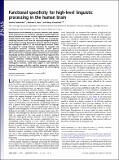Functional specificity in the human brain: A window into the functional architecture of the mind
Author(s)
Kanwisher, Nancy
DownloadKanwisher-2011-Functional specificity.pdf (1.058Mb)
PUBLISHER_POLICY
Publisher Policy
Article is made available in accordance with the publisher's policy and may be subject to US copyright law. Please refer to the publisher's site for terms of use.
Alternative title
Inaugural Article: Functional Specificity in the Human Brain: A Window into the Functional Architecture of the Mind
Terms of use
Metadata
Show full item recordAbstract
Is the human mind/brain composed of a set of highly specialized components, each carrying out a specific aspect of human cognition, or is it more of a general-purpose device, in which each component participates in a wide variety of cognitive processes? For nearly two centuries, proponents of specialized organs or modules of the mind and brain—from the phrenologists to Broca to Chomsky and Fodor—have jousted with the proponents of distributed cognitive and neural processing—from Flourens to Lashley to McClelland and Rumelhart. I argue here that research using functional MRI is beginning to answer this long-standing question with new clarity and precision by indicating that at least a few specific aspects of cognition are implemented in brain regions that are highly specialized for that process alone. Cortical regions have been identified that are specialized not only for basic sensory and motor processes but also for the high-level perceptual analysis of faces, places, bodies, visually presented words, and even for the very abstract cognitive function of thinking about another person’s thoughts. I further consider the as-yet unanswered questions of how much of the mind and brain are made up of these functionally specialized components and how they arise developmentally.
Description
This contribution is part of the special series of Inaugural Articles by members of the National Academy of Sciences elected in 2005.
Date issued
2010-06Department
Massachusetts Institute of Technology. Department of Brain and Cognitive Sciences; McGovern Institute for Brain Research at MITJournal
Proceedings of the National Academy of Sciences of the United States of America
Publisher
National Academy of Sciences (U.S.)
Citation
Kanwisher, N. “Inaugural Article: Functional Specificity in the Human Brain: A Window into the Functional Architecture of the Mind.” Proceedings of the National Academy of Sciences 107.25 (2010): 11163–11170. Web.
Version: Final published version
ISSN
0027-8424
1091-6490